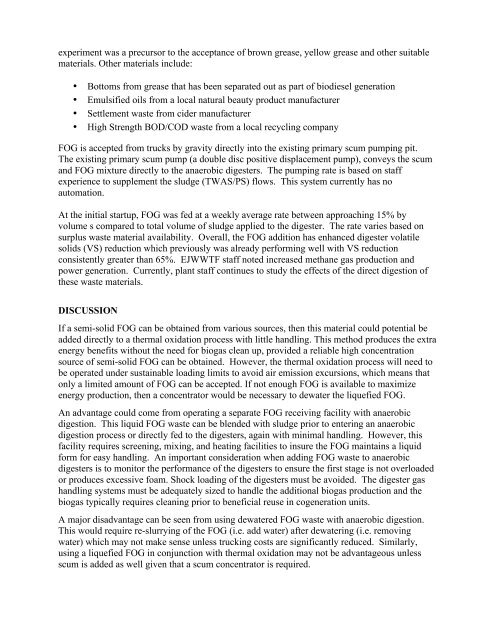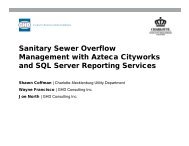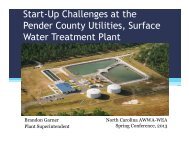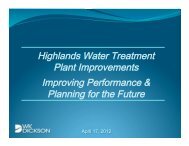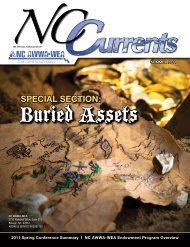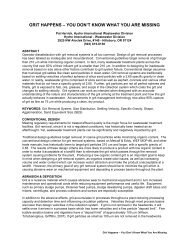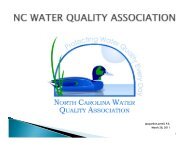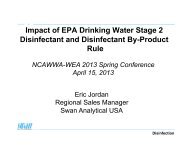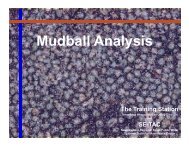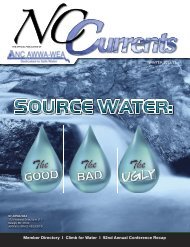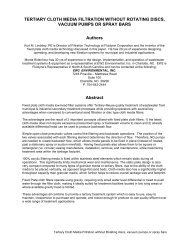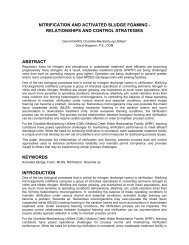HANDLING FATS, OILS & GREASES (FOG) AT WASTEWATER ...
HANDLING FATS, OILS & GREASES (FOG) AT WASTEWATER ...
HANDLING FATS, OILS & GREASES (FOG) AT WASTEWATER ...
Create successful ePaper yourself
Turn your PDF publications into a flip-book with our unique Google optimized e-Paper software.
experiment was a precursor to the acceptance of brown grease, yellow grease and other suitablematerials. Other materials include:• Bottoms from grease that has been separated out as part of biodiesel generation• Emulsified oils from a local natural beauty product manufacturer• Settlement waste from cider manufacturer• High Strength BOD/COD waste from a local recycling company<strong>FOG</strong> is accepted from trucks by gravity directly into the existing primary scum pumping pit.The existing primary scum pump (a double disc positive displacement pump), conveys the scumand <strong>FOG</strong> mixture directly to the anaerobic digesters. The pumping rate is based on staffexperience to supplement the sludge (TWAS/PS) flows. This system currently has noautomation.At the initial startup, <strong>FOG</strong> was fed at a weekly average rate between approaching 15% byvolume s compared to total volume of sludge applied to the digester. The rate varies based onsurplus waste material availability. Overall, the <strong>FOG</strong> addition has enhanced digester volatilesolids (VS) reduction which previously was already performing well with VS reductionconsistently greater than 65%. EJWWTF staff noted increased methane gas production andpower generation. Currently, plant staff continues to study the effects of the direct digestion ofthese waste materials.DISCUSSIONIf a semi-solid <strong>FOG</strong> can be obtained from various sources, then this material could potential beadded directly to a thermal oxidation process with little handling. This method produces the extraenergy benefits without the need for biogas clean up, provided a reliable high concentrationsource of semi-solid <strong>FOG</strong> can be obtained. However, the thermal oxidation process will need tobe operated under sustainable loading limits to avoid air emission excursions, which means thatonly a limited amount of <strong>FOG</strong> can be accepted. If not enough <strong>FOG</strong> is available to maximizeenergy production, then a concentrator would be necessary to dewater the liquefied <strong>FOG</strong>.An advantage could come from operating a separate <strong>FOG</strong> receiving facility with anaerobicdigestion. This liquid <strong>FOG</strong> waste can be blended with sludge prior to entering an anaerobicdigestion process or directly fed to the digesters, again with minimal handling. However, thisfacility requires screening, mixing, and heating facilities to insure the <strong>FOG</strong> maintains a liquidform for easy handling. An important consideration when adding <strong>FOG</strong> waste to anaerobicdigesters is to monitor the performance of the digesters to ensure the first stage is not overloadedor produces excessive foam. Shock loading of the digesters must be avoided. The digester gashandling systems must be adequately sized to handle the additional biogas production and thebiogas typically requires cleaning prior to beneficial reuse in cogeneration units.A major disadvantage can be seen from using dewatered <strong>FOG</strong> waste with anaerobic digestion.This would require re-slurrying of the <strong>FOG</strong> (i.e. add water) after dewatering (i.e. removingwater) which may not make sense unless trucking costs are significantly reduced. Similarly,using a liquefied <strong>FOG</strong> in conjunction with thermal oxidation may not be advantageous unlessscum is added as well given that a scum concentrator is required.


